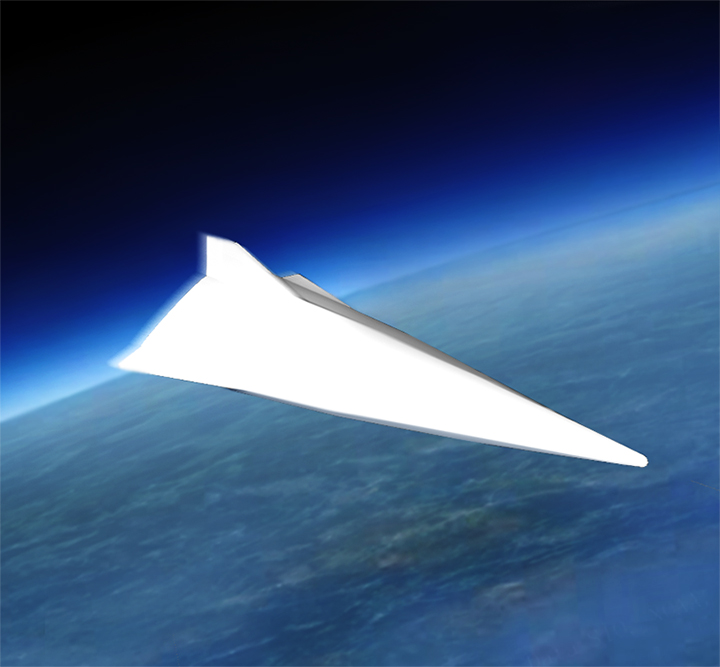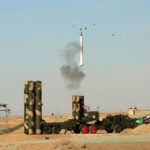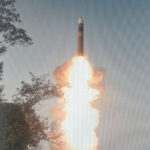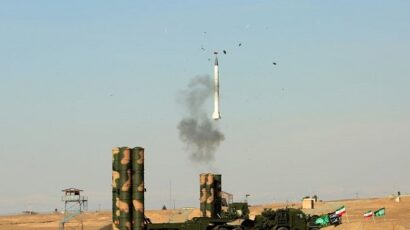Orbital hypersonic delivery systems threaten strategic stability
By Ritwik Gupta | June 13, 2023
 Artist's concept of a Chinese hypersonic glide vehicle. Credit: 果壳军事 / Wikimedia Commons
Artist's concept of a Chinese hypersonic glide vehicle. Credit: 果壳军事 / Wikimedia Commons
In the summer of 2021, the ghost of the Cold War unexpectedly reared its head on an unremarkable Chinese peninsula. A Long March rocket roared into space and released a hypersonic glide vehicle, a missile that can travel at five to 25 times the speed of sound, which made a partial orbit of the Earth before diving toward its target. Although the missile landed a couple dozen miles from its target, the secret test alarmed US military officials and reportedly caught them off guard. It demonstrated China’s surprisingly rapid development of a speedy, maneuverable weapon system that can fly low trajectories and dodge missile-defense and early-warning systems better than a ballistic missile, which travels along a predictable arc and does not go into orbit.
In late November 2022, the Pentagon released some details about China’s new system, reporting that the glide vehicle traveled almost 25,000 miles during its 2021 test and reached hypersonic speeds. The system fit all the characteristics of a fractional orbital bombardment system, an old Soviet technique built to defeat American missile-defense radars in the Arctic Circle but never before paired with a hypersonic glide vehicle. As the name suggests, such systems complete a fraction of an orbit around the Earth before re-entering the atmosphere. The most concerning aspect of the 2021 Chinese test is that such a rapid delivery system could be used to deliver a nuclear payload from space.
Hypersonic glide vehicles alone do not pose a significant risk to strategic stability. Despite all the media hype about the Kinzhal “hypersonic missiles” that Russia has used to attack Ukraine (which are actually air-launched ballistic missiles, rather than hypersonic glide vehicles or cruise missiles), the reduced time-to-target and increased destructiveness of Kinzhals are negligible compared with conventional arsenals. However, when hypersonic glide vehicles are paired with fractional orbital bombardment systems, the strengths of both systems overcome the individual weaknesses that would otherwise make them a manageable threat.
The combo is called a fractional orbital hypersonic delivery system. It’s faster than an intercontinental ballistic missile, and more difficult to track.
A marriage of two technologies. In 2020, Cameron L. Tracy of the Union of Concerned Scientists, together with David Wright of MIT, modeled the performance of hypersonic glide vehicles to reach two key conclusions: These vehicles may take longer to reach an intended target than ballistic missiles on depressed trajectories, and they may be more detectable by space-based early-warning systems than previously suggested. Andrew Reddie, the faculty director of UC Berkeley’s Risk and Security Lab, posits that hypersonic glide vehicles do not pose a significant risk to strategic stability and may even strengthen it due to shared mutual vulnerabilities.
When a hypersonic glide vehicle is paired with a fractional orbital bombardment system, though, the combined system goes beyond the bounds of prior analyses of glide vehicle dynamics. The marriage of these two technologies has been a relationship brewing for decades.
A fractional orbital bombardment system is a payload that is delivered into low-Earth orbit but re-enters the atmosphere to bombard a target before completing a full orbit. This system has several advantages over traditional ballistic missiles: its range covers the entire Earth; it can execute an attack from a much larger number of directions; and the time required for payload delivery can be many minutes shorter than for a comparable ICBM payload.
The Soviet Union developed a functional fractional orbital bombardment system in the late 1960s. However, these bombardment systems were not deemed worthwhile for the United States to pursue in the 20th century for a few reasons:
- Such systems were not as precise or accurate as ICBMs, with only 50 percent of shots landing within 0.68 miles of their target.
- The United States had developed meaningful space-based early detection capabilities that nullified the benefit of a faster time-to-target.
- Low Earth orbit was difficult to get into, requiring reduced payload sizes.
- The SALT II treaty explicitly banned orbital bombardment systems.
But when fractional orbital bombardment systems are combined with hypersonic glide vehicles to create fractional orbital hypersonic delivery systems, those downsides no longer matter.
Dodge, duck, dip, and dive. Fractional orbital bombardment systems are inaccurate delivery mechanisms. The large velocity of the payload during re-entry and subsequent delivery creates a significant degree of error in targeting. In the modern era of precision munitions and treaties mandating that collateral damage be kept to a minimum, fractional orbital bombardment systems are undesirable weapons systems.
Unlike error-prone bombardment systems, a hypersonic glide vehicle can maneuver and adjust its flight path precisely after re-entry into the atmosphere. It can sustain atmospheric flight for an extended period (a “glide”), or even exit and re-enter the atmosphere later (a “skip”). Non-ballistic atmospheric entry enables hypersonic glide vehicles to avoid interception by following unpredictable flight paths, and to fly below the ceilings of radar detection systems. Any imprecision in initial atmospheric re-entry can be corrected by finely adjusting the flight path of the hypersonic glide vehicle.
A fractional orbital hypersonic delivery system combines these advantages with orbital bombardment to create the best of both worlds. A fractional orbital hypersonic delivery system can deliver payloads up to 10 minutes faster than ICBMs. The trajectories of fractional orbital hypersonic delivery systems are difficult to track, both because they stay closer to the Earth and therefore below the floor of missile-defense radars, and also because of the increased maneuverability of the hypersonic glide vehicle payload. The theoretical increased precision and accuracy of this combination of systems makes fractional orbital bombardment systems viable in the modern era of precision munitions.
As an additional point, accelerating a glide vehicle to hypersonic speeds is more easily done outside the Earth’s atmosphere than inside it. Because the Earth’s gravitational pull weakens with distance from the surface, and empty space has virtually no friction to slow down a moving object, a hypersonic glide vehicle can reach high speeds more efficiently than a vehicle traveling through the atmosphere. That means a hypersonic glide vehicle will burn less fuel—and emit less of the telltale heat that can be detected by early-warning systems.
Lost in the crowd. Low Earth orbit is increasingly accessible. By the spring of 2022, the number of satellites in space was estimated to be about 5,500. By 2030, that number is projected to grow by an additional 58,000 satellites. This boom is happening because of drastic reductions in launch costs. Private companies such as Rocket Lab, SpaceX, and others have driven the cost of launch down by an order of magnitude, with reductions of a similar scale projected in coming years. The space industry has standardized payload sizes, resulting in greater interoperability and reduced payload development costs. Additionally, novel payload delivery mechanisms such as SpinLaunch’s electric-powered launch system are demonstrating new ways to get large payloads into orbit.
The proliferation of satellites in low Earth orbit makes it increasingly difficult to understand and track individual payloads. While companies such as LeoLabs are attempting to characterize and monitor every object in low Earth orbit, their reliability under increased proliferation is questionable.
In the future, fractional orbital hypersonic delivery system might be staged years ahead of time and maintained in low Earth orbit while hiding among other spacecraft, completing multiple orbits, rather than a fractional one, before being deployed. Large payloads might be arrayed in space over time. Only when these systems need to be used would final adjustments be made to their orbits to rapidly deliver hypersonic glide vehicles to their targets. The Soviets explored multiple orbit bombardment systems before deciding to invest most of their efforts in fractional orbit systems.
Living in a gray zone. The SALT II agreement between the United States and the Soviet Union forbade the use of fractional orbital bombardment systems. While never formally ratified by either government, the agreement was upheld even past its expiration with the signing of the START I treaty in 1991. The START I treaty modified the SALT II prohibition, limiting it to any orbital bombardment system with a nuclear payload. In this spirit, the currently active Outer Space Treaty of 1967 forbids the installation of any nuclear weapons or weapons of mass destruction in “orbit around the Earth.”
“Orbit around the Earth” is purposefully specific phrasing. This allows weapons systems such as intercontinental ballistic missiles to briefly enter outer space without violating the treaty—and arguably also allows fractional orbital bombardment systems. Analysis during the Lyndon B. Johnson presidency concluded that fractional orbital bombardment systems were legal under the White House’s interpretation of the Outer Space Treaty. As a result, there are no treaties in force today that ban the use of fractional orbital bombardment systems or fractional orbital hypersonic delivery systems.
This analysis should be revisited. China’s aforementioned 2021 test of an orbital delivery system’s capability is a concerning development given China’s shifting nuclear posture. White papers from the Chinese Ministry of National Defense highlight China’s commitment to developing both nuclear and conventional capabilities in “all battlespaces.” China has increasingly viewed space as a valid battlespace since the early 2000s and has invested in nuclear-capable hypersonic glide vehicles. A Chinese nuclear fractional orbital hypersonic delivery system is not out of the question.
This possibility comes with a silver lining. China has publicly affirmed its commitment to the Outer Space Treaty. In 2008, China and Russia worked together to draft the Prevention of an Arms Race in Space (PAROS) Treaty. The draft proposes a prohibition on the first placement of weapons in outer space—a resolution the United States voted against—which provides some confidence that China will not stage weapons systems that complete multiple orbits of the Earth.
A meaningful threat to stability? Orbital hypersonic delivery systems are a meaningful new development in the class of systems that can be used for a first strike. Any nation that possesses meaningful nuclear capabilities, and acquires a fractional orbital hypersonic delivery system, would be able to deliver large nuclear payloads faster than any system currently in existence while remaining undetected for a significantly longer portion of its flight. China’s development of this capability is the bellwether of a renewed global interest in developing first-strike capabilities.
A mathematical analysis of the dynamics of fractional orbital hypersonic delivery systems that expands on the study conducted by Tracy and Cameron is needed. Such systems possess the capacity to be more undetectable than hypersonic glide vehicles, to reach their targets faster than both hypersonic glide vehicles and ICBMs, and to stay latent for years before being delivered to their targets.
Together, we make the world safer.
The Bulletin elevates expert voices above the noise. But as an independent nonprofit organization, our operations depend on the support of readers like you. Help us continue to deliver quality journalism that holds leaders accountable. Your support of our work at any level is important. In return, we promise our coverage will be understandable, influential, vigilant, solution-oriented, and fair-minded. Together we can make a difference.
Keywords: fractional orbital bombardment, hypersonic glide vehicle
Topics: Nuclear Weapons, Opinion, Voices of Tomorrow
















We have been in a state of mutual vulnerability with China for a long time now. FOBS does not change this. It only blunts our attempts at missile defense, which the Chinese fear could give us the ability to launch a first strike and then defend against a “ragged” response. That said, a treaty that outlaws nuclear weapons in orbit would be a good thing. Verifying it would be an interesting challenge.